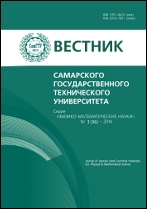|
This article is cited in 10 scientific papers (total in 10 papers)
Mathematical Modeling, Numerical Methods and Software Complexes
Mathematical modeling of hereditary elastically deformable body on the basis
of structural models and fractional integro-differentiation Riemann–Liouville apparatus
E. N. Ogorodnikov, V. P. Radchenko, L. G. Ungarova
Samara State Technical University, Samara, 443100, Russian Federation
(published under the terms of the Creative Commons Attribution 4.0 International License)
Abstract:
The standard one-dimensional generalized model of a viscoelastic body and some of its special cases—Voigt, Maxwell, Kelvin and Zener models are considered. Based on the V. Volterra hypothesis of hereditary elastically deformable solid body and the method of structural modeling the fractional analogues of classical rheological models listed above are introduced. It is shown that if an initial V. Volterra constitutive relation uses the Abel-type kernel, the fractional derivatives arising in constitutive relations will be the Rieman–Liouville derivatives on the interval. It is noted that in many works deal with mathematical models of hereditary elastic bodies, the authors use some fractional derivatives, convenient for the integral transforms, for example, the Riemann–Liouville derivatives on the whole real number line or Caputo derivatives. The explicit solutions of initial value problems for the model fractional differential equations are not given. The correctness of the Cauchy problem is shown for some linear combinations of functions of stress and strain for constitutive relations in differential form with Riemann–Liouville fractional derivatives. Explicit solutions of the problem of creep at constant stress in steps of loading and unloading are found. The continuous dependence of the solutions on the model fractional parameter is proved, in the sense that these solutions transform into a well-known solutions for classical rheological models when $\alpha\to1$. We note the persistence of instantaneous elastic deformation in the loading and unloading process for fractional Maxwell, Kelvin and Zener models. The theorems on the existence and asymptotic properties of the solutions of creep problem are presented and proved. The computer system identifying the parameters of the fractional mathematical model of the viscoelastic body is developed, the accuracy of the approximations for experimental data and visualization solutions of creep problems is evaluated. Test data with constant tensile stresses of polyvinyl chloride tube were used for experimental verification of the proposed models. The results of the calculated data based on the fractional analog of Voigt model are presented. There is a satisfactory agreement between the calculated and experimental data.
Keywords:
structural models, rheological models, viscoelasticity, creep, fractional calculus, the operators of Riemann–Liouville fractional integration and differentiation, fractional integral and differential equations, parametric identification, experimental data, Mittag–Leffler type function.
Original article submitted 05/XI/2015
revision submitted – 19/II/2016
Citation:
E. N. Ogorodnikov, V. P. Radchenko, L. G. Ungarova, “Mathematical modeling of hereditary elastically deformable body on the basis
of structural models and fractional integro-differentiation Riemann–Liouville apparatus”, Vestn. Samar. Gos. Tekhn. Univ., Ser. Fiz.-Mat. Nauki [J. Samara State Tech. Univ., Ser. Phys. Math. Sci.], 20:1 (2016), 167–194
Linking options:
https://www.mathnet.ru/eng/vsgtu1456 https://www.mathnet.ru/eng/vsgtu/v220/i1/p167
|

| Statistics & downloads: |
| Abstract page: | 896 | | Full-text PDF : | 439 | | References: | 108 | | First page: | 3 |
|




 Contact us:
Contact us: Terms of Use
Terms of Use
 Registration to the website
Registration to the website Logotypes
Logotypes








 Citation in format
Citation in format 
